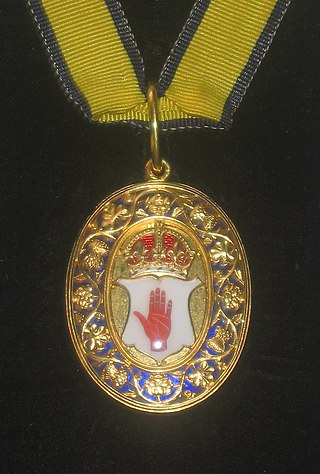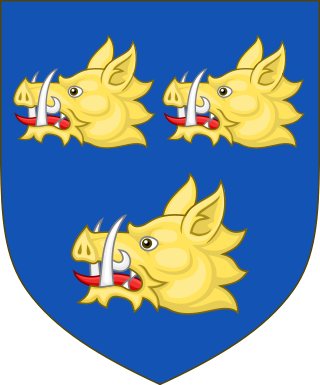
The Gordon baronetcy of Gordonstoun was created on 28 May 1625 in the Baronetage of Nova Scotia for Robert Gordon of Gordonstoun, fourth son of Alexander Gordon, 12th Earl of Sutherland. It was until 1908 the premier baronetcy in Scotland. [1]

The Gordon baronetcy of Gordonstoun was created on 28 May 1625 in the Baronetage of Nova Scotia for Robert Gordon of Gordonstoun, fourth son of Alexander Gordon, 12th Earl of Sutherland. It was until 1908 the premier baronetcy in Scotland. [1]
The baronetcy, which was created with remainder to all male descendants, [1] became dormant 24 March 1908. It is not considered extant by the Official Roll of the Baronetage. [3]

A baronet or the female equivalent, a baronetess, is the holder of a baronetcy, a hereditary title awarded by the British Crown. The title of baronet is mentioned as early as the 14th century; however, in its current usage it was created by James I of England in 1611 as a means of raising funds for the crown.
Viscount of Kenmure was a title in the Peerage of Scotland. It was created by Charles I in 1633 for the prominent Presbyterian Sir John Gordon, 2nd Baronet. He was made Lord Lochinvar at the same time, also in the Peerage of Scotland. Both titles were created with remainder to "heirs male whatsoever bearing the arms and name of Gordon"
There have been eleven Gordon baronetcies. Of those, two are extant as of 2024, with the baronets of Embo dormant.

The Dalyell Baronetcy in the Baronetage of Nova Scotia was created 7 November 1685 for a Scottish General, Thomas Dalyell of the Binns. The succession of the title is unusual in that, in default of heirs male, it can pass by special remainder to tailzie succeeding him in the estate of The Binns.
There have been four baronetcies created for persons with the surname Leslie, one in the Baronetage of Nova Scotia, one in the Baronetage of Ireland, one in the Baronetage of Great Britain and one in the Baronetage of the United Kingdom. Three of the creations are extant as of 2010.
There have been six Cunningham baronetcies:
The Douglas of Glenbervie, Kincardine Baronetcy was created on 28 May 1625 in the Baronetage of Nova Scotia.

There have been four baronetcies created for persons with the surname Hope, three in the Baronetage of Nova Scotia and one in the Baronetage of the United Kingdom. As of 2010 one creation is extant, one dormant and two extinct.
There have been nine baronetcies created for persons with the surname Moore, two in the Baronetage of England, one in the Baronetage of Ireland, two in the Baronetage of Great Britain and four in the Baronetage of the United Kingdom. As of 2014 two creations are extant and one is considered dormant.
There have been four baronetcies created for persons with the surname Seton, all in the Baronetage of Nova Scotia. As of 2008 one creation is extant, one dormant and two extinct.
Sir William Williams, 6th Baronet of Faenol (Vaynol) was a Welsh politician and landowner elected as MP for Caernarvonshire from 1689 until his death.
There have been three baronetcies created for persons with the surname Duncan, one in the Baronetage of Great Britain and two in the Baronetage of the United Kingdom. All three creations are extinct.
There have been three Keith Baronetcies.
There have been three baronetcies created for people with the surname Moncreiffe or Moncreiff, two in the Baronetage of Nova Scotia and one in the Baronetage of the United Kingdom. Two of the titles are dormant, as the heir has not proved his descent, and one is extant, though its holder does not bear the surname of Moncreiffe.
Sir Robert Gordon, 4th Baronet (1696–1772) was a Scottish landowner and politician who sat in the House of Commons from 1715 to 1722.

The Mackenzie baronetcy, of Coul (Coull) in the County of Ross, was created in the Baronetage of Nova Scotia on 16 October 1673 for Kenneth Mackenzie. His father Alexander Mackenzie of Coul was the illegitimate son of Colin Cam Mackenzie, 11th of Kintail, and half-brother of Kenneth Mackenzie, 1st Lord Mackenzie of Kintail, ancestor of the Earls of Seaforth, and of Sir Roderick Mackenzie, ancestor of the Earls of Cromarty. The 3rd Baronet was involved in the Jacobite rising of 1715. He was attainted with the baronetcy forfeited.

The Gordon baronetcy of Lesmore, Aberdeenshire was created on 2 September 1625 in the Baronetage of Nova Scotia for James Gordon, son of Alexander Gordon.

The Gordon baronetcy of Embo, Sutherland was created on 18 June 1631 for John Gordon, son of John Gordon who was a large landowner in the county.

The Innes baronetcy, of Coxton in the County of Moray, was created in the Baronetage of Nova Scotia on 20 March 1686 for Alexander Innes, Member of the Scottish Parliament for Moray, with remainder to heirs male whatsoever. He was a descendant of John Innes of Coxton, grandson of Patrick Innes, great-great-great-uncle of the first of the Innes baronets of Balvenie.